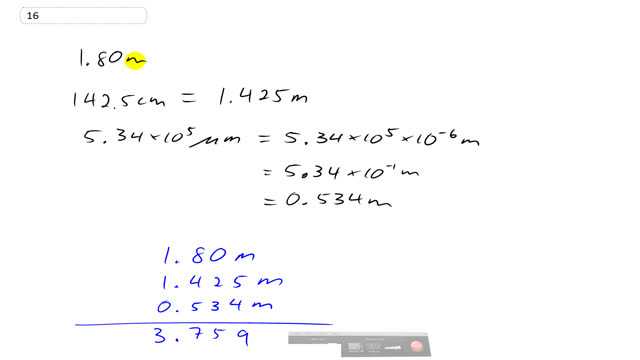
Express the following sum with correct number of significant figures: .

In order to watch this solution you need to have a subscription.
This is Giancoli Answers with Mr. Dychko. To add these numbers together with the correct number of significant figures, we have to express them all without any prefixes or at least all have the same units. So this is meters—1.80 meters—and so this 142.5 centimeters has to be expressed in meters—move the decimal point twice to the left to make it into meters. This 5.34 times 10 to the 5 micrometers is a bit of a weird one; it's uncommon to have multiply by power of 10 and then have a prefix as well because normally, the prefix is intended to take care of any multiplying by powers of 10 but anyway, we can deal with it nevertheless. Micro is the prefix that means times 10 to the power of negative 6 and so we have times 10 to the 5 in the number we are given times 10 to the negative 6 is replacing the micro and that gives times 10 to the power negative 1 10 to the 5 times 10 to the negative 6 and we can write this in standard form without any multiplying by any powers of 10—0.534— so times 10 to the minus 1 means we move the decimal once to the left. And then we write those with all the decimal points lined up and then we can see how to figure out the significant figures. So our answer is gonna be 3.76 meters because this is the number that limits our precision in our answer. So our answer will be precise to the extent of the least precise number we are working with. So this number here is precise to the hundredths place and so our answer will be precise only to the hundredths place; we can't use a thousandths even though these two quantities are measured to the nearest thousandths because this number here is measured only to the hundredths and so when you are doing addition, you don't really count significant figures— that's a multiplying and dividing topic where you count three or four and so on— instead with addition and subtraction, you are just looking at the place value that is least precise in any of your numbers and your answer will have the precision of the least precise number you are working with; hundredths place in this case.